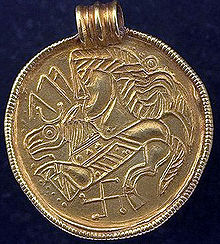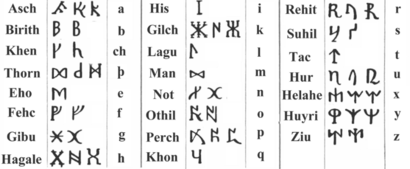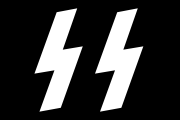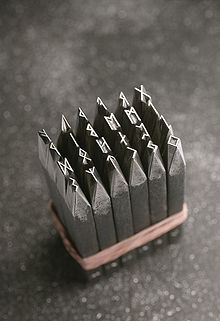- Runic script
-
"Rune" redirects here. For other uses, see Rune (disambiguation).
Runic Type Alphabet Languages Germanic languages Time period Elder Futhark from the 2nd century AD Parent systems Phoenician- Old Italic
- Runic
Child systems Younger Futhark, Anglo-Saxon futhorc ISO 15924 Runr, 211 Direction Left-to-right Unicode alias Runic Unicode range U+16A0–U+16FF Note: This page may contain IPA phonetic symbols. History of the alphabet Proto-Sinaitic script? 19 c. BCE
- Ugaritic 15 c. BCE
- Proto-Canaanite 14 c. BCE
- Phoenician 12 c. BCE
- Greek 8 c. BCE
- Aramaic 8 c. BCE
- Kharoṣṭhī 6 c. BCE
- Brāhmī & Indic 6 c. BCE
- Hebrew 3 c. BCE
- Thaana 4 c. BCE
- Pahlavi 3 c. BCE
- Avestan 4 c. CE
- Palmyrene 2 c. BCE
- Syriac 2 c. BCE
- Sogdian 2 c. BCE
- Orkhon (Old Turkic) 6 c. CE
- Old Hungarian c. 650
- Old Uyghur
- Mongolian 1204
- Orkhon (Old Turkic) 6 c. CE
- Nabataean 2 c. BCE
- Arabic 4 c. CE
- Sogdian 2 c. BCE
- Mandaic 2 c. CE
- Paleohispanic 7 c. BCE
- Paleo-Hebrew 10 c. BCE
- Samaritan 6 c. BCE
- Phoenician 12 c. BCE
- Epigraphic South Arabian 9 c. BCE
- Ge’ez 5–6 c. BCE
Meroitic 3 c. BCEOgham 4 c. CEHangul 1443Zhuyin (Bopomofo) 1913The runic alphabets are a set of related alphabets using letters known as runes to write various Germanic languages before the adoption of the Latin alphabet and for specialized purposes thereafter. The Scandinavian variants are also known as futhark (or fuþark, derived from their first six letters of the alphabet: F, U, Þ, A, R, and K); the Anglo-Saxon variant is futhorc (due to sound changes undergone in Old English by the same six letters). Runology is the study of the runic alphabets, runic inscriptions, runestones, and their history. Runology forms a specialized branch of Germanic linguistics.
The earliest runic inscriptions date from around AD 150. The characters were generally replaced by the Latin alphabet as the cultures that had used runes underwent Christianization by around AD 700 in central Europe and by around AD 1100 in Northern Europe. However, the use of runes persisted for specialized purposes in Northern Europe. Until the early 20th century runes were used in rural Sweden for decoration purposes in Dalarna and on Runic calendars.
The three best-known runic alphabets are the Elder Futhark (around 150–800), the Anglo-Saxon Futhorc (400–1100), and the Younger Futhark (800–1100). The Younger Futhark is further divided into the long-branch runes (also called Danish, although they were also used in Norway and Sweden), short-branch or Rök runes (also called Swedish-Norwegian, although they were also used in Denmark), and the stavesyle or Hälsinge runes (staveless runes). The Younger Futhark developed further into the Marcomannic runes, the Medieval runes (1100–1500), and the Dalecarlian runes (around 1500–1800).
Historically, the runic alphabet is a derivation of the Old Italic alphabets of antiquity, with the addition of some innovations. Which variant of the Old Italic family in particular gave rise to the runes is uncertain, suggestions including Raetic, Etruscan or Old Latin candidates. All these scripts at the time had the same angular letter shapes suited for epigraphy which would become characteristic of the runes. The process of transmission of the script (the oldest inscriptions being found in Denmark and Northern Germany, not near Italy) is also unknown. A "West Germanic hypothesis" suggests transmission via Elbe Germanic groups, while a "Gothic hypothesis" assumes transmission via East Germanic expansion.
Contents
History and usage
An inscription using both cipher runes, the Elder Futhark and the Younger Futhark, on the 9th century Rök Runestone in Sweden.
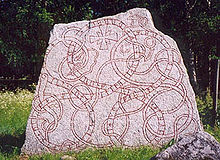 A Younger Futhark inscription on the 12th century Vaksala Runestone in Sweden.
A Younger Futhark inscription on the 12th century Vaksala Runestone in Sweden.
The runes were in use among the Germanic peoples from the 1st or 2nd century AD.[1] This period corresponds to the late Common Germanic stage linguistically, with a continuum of dialects not yet clearly separated into the three branches of later centuries; North Germanic, West Germanic, and East Germanic.
No distinction is made in surviving runic inscriptions between long and short vowels, although such a distinction was certainly present phonologically in the spoken languages of the time. Similarly, there are no signs for labiovelars in the Elder Futhark (such signs were introduced in both the Anglo-Saxon futhorc and the Gothic alphabet as variants of p; see peorð.)
The name runes contrasts with Latin or Greek letters. It is attested on a 6th century Alamannic runestaff as runa, and possibly as runo on the 4th century Einang stone. The name is from a root run- (Gothic runa), meaning "secret" or "whisper". The root run- can also be found in the Baltic languages meaning "speech". In Lithuanian, runoti has two meanings: "to cut (with a knife)" or "to speak".[2]
Origins
Main article: Elder FutharkThe runes developed centuries after the Old Italic alphabets from which they are historically derived. The debate on the development of the runic script concerns the question which of the Italic alphabets should be taken as their point of origin, and which, if any, signs should be considered original innovations added to the letters found in the Italic scripts. The historical context of the script's origin is the cultural contact between Germanic people, who often served as mercenaries in the Roman army, and the Italic peninsula during the Roman imperial period (1st c. BC to 5th c. AD). The formation of the Elder Futhark was complete by the early 5th century, with the Kylver Stone being the first evidence of the futhark ordering as well as of the p rune.
Specifically, the Raetic alphabet of Bolzano, is often advanced as a candidate for the origin of the runes, with only five Elder Futhark runes (ᛖ e, ᛇ ï, ᛃ j, ᛜ ŋ, ᛈ p) having no counterpart in the Bolzano alphabet (Mees 2000). Scandinavian scholars tend to favor derivation from the Latin alphabet itself over Raetic candidates.[3] A "North Etruscan" thesis is supported by the inscription on the Negau helmet dating to the 2nd century BC[4] This is in a northern Etruscan alphabet, but features a Germanic name, Harigast.
The angular shapes of the runes are shared with most contemporary alphabets of the period used for carving in wood or stone. A peculiarity of the runic alphabet is the absence of horizontal strokes, although this characteristic is also shared by other alphabets, such as the early form of the Latin alphabet used for the Duenos inscription, and it is not universal especially among early runic inscriptions, which frequently have variant rune shapes including horizontal strokes.
The "West Germanic hypothesis" speculates on an introduction by West Germanic tribes. This hypothesis is based on claiming that the earliest inscriptions of the 2nd and 3rd centuries, found in bogs and graves around Jutland (the Vimose inscriptions), exhibit word endings that, being interpreted by Scandinavian scholars to be Proto-Norse, are considered unresolved and having been long the subject of discussion. Inscriptions like wagnija, niþijo, and harija are supposed to incarnate tribe names, tentatively proposed to be Vangiones, the Nidensis and the Harii, tribes located in the Rhineland.[5] Since names ending in -io reflect Germanic morphology representing the Latin ending -ius, and the suffix -inius was reflected by Germanic -inio-,[6] the question of the problematic ending -ijo in masculine Proto-Norse would be resolved by assuming Roman (Rhineland) influences, while "the awkward ending -a of laguþewa (cf. Syrett 1994:44f.) can be solved by accepting the fact that the name may indeed be West Germanic;"[7] however, it should be noted that in the early Runic period differences between Germanic languages are generally assumed to be small. Another theory assumes a Northwest Germanic unity preceding the emergence of Proto-Norse proper from roughly the 5th century.[8] An alternative suggestion explaining the impossibility to classify the earliest inscriptions as either North or West Germanic is forwarded by È. A. Makaev, who assumes a "special runic koine", an early "literary Germanic" employed by the entire Late Common Germanic linguistic community after the separation of Gothic (2nd to 5th centuries), while the spoken dialects may already have been more diverse.[9]
Early inscriptions
 An illustration of the Ring of Pietroassa (from between AD 250 to 400) by Henri Trenk, 1875.
An illustration of the Ring of Pietroassa (from between AD 250 to 400) by Henri Trenk, 1875.
Runic inscriptions from the 400 year period of c. AD 150 to 550 are referred to as "Period I" inscriptions. These inscriptions are generally in Elder Futhark, but the set of letter shapes and bindrunes employed is far from standardized. Notably the j, s and ŋ runes undergo considerable modifications, while others, such as p and ï, remain unattested altogether prior the first full futhark row on the Kylver Stone (c. AD 400).
Artifacts such as spear-mounts, shield-heads have been found which bear runic marking can be dated to 200 A.D., as evidenced by artifacts found across northern Europe in Schleswig (North Germany), Fyn, Sjaeland, Jylland (Denmark), and Skåne (Sweden). Earlier, but less reliable, artifacts have been found in Meldorf, Süderithmarschen, North Germany; these include brooches and comes found in graves, and are supposed to have the earliest markings resembling runic inscriptions.
Theories of the existence of separate Gothic runes have been advanced, even identifying them as the original alphabet from which the Futhark were derived, but these have little support in actual findings (mainly the spearhead of Kovel, with its right-to-left inscription, its T-shaped tiwaz and its rectangular dagaz). If there ever were genuinely Gothic runes, they were soon replaced by the Gothic alphabet. The letters of the Gothic alphabet, however, as given by the Alcuin manuscript (9th century), are obviously related to the names of the Futhark. The names are clearly Gothic, but it is impossible to say whether they are as old as, or even older than, the letters themselves. A handful of Elder Futhark inscriptions were found in Gothic territory, such as the 3rd to 5th century Ring of Pietroassa. The Encyclopedia Britannica even suggests the original development of the runes may have been due to the Goths.[10]
Magical or divinatory use
 Closeup of the runic inscription found on the 6th or 7th century Björketorp Runestone located in Blekinge, Sweden.
Closeup of the runic inscription found on the 6th or 7th century Björketorp Runestone located in Blekinge, Sweden. Main article: Runic magic
Main article: Runic magicIn stanza 157 of Hávamál, the runes are attributed with the power to bring that which is dead to life. In this stanza, Odin recounts a spell:
- Þat kann ek it tolfta,
- ef ek sé á tré uppi
- váfa virgilná,:
- svá ek ríst ok í rúnum fák,
- at sá gengr gumi
- ok mælir við mik.[11]
- I know a twelfth one if I see,
- up in a tree,
- a dangling corpse in a noose,
- I can so carve and color the runes,
- that the man walks
- And talks with me.[12]
The earliest runic inscriptions found on artifacts give the name of either the craftsman or the proprietor, or, sometimes, remain a linguistic mystery. Due to this, it is possible that the early runes were not so much used as a simple writing system, but rather as magical signs to be used for charms. Although some say the runes were used for divination, there is no direct evidence to suggest they were ever used in this way. The name rune itself, taken to mean "secret, something hidden", seems to indicate that knowledge of the runes was originally considered esoteric, or restricted to an elite. The 6th century Björketorp Runestone warns in Proto-Norse using the word rune in both senses:
Haidzruno runu, falahak haidera, ginnarunaz. Arageu haeramalausz uti az. Weladaude, sa'z þat barutz. Uþarba spa.
I, master of the runes(?) conceal here runes of power. Incessantly (plagued by) maleficence, (doomed to) insidious death (is) he who breaks this (monument). I prophesy destruction / prophecy of destruction.[13]
The same curse and use of the word rune is also found on the Stentoften Runestone. There are also some inscriptions suggesting a medieval belief in the magical significance of runes, such as the Franks Casket (700 AD) panel.
Charm words, such as auja, laþu, laukaR and most commonly, alu,[14] appear on a number of Migration period Elder Futhark inscriptions as well as variants and abbreviations of them. Much speculation and study has been produced on the potential meaning of these inscriptions. Rhyming groups appear on some early bracteates that may also be magic in purpose, such as salusalu and luwatuwa. Further, an inscription on the Gummarp Runestone (500 to 700 AD) gives a cryptic inscription describing the use of three runic letters followed by the Elder Futhark f-rune written three times in succession.[15]
Nevertheless, it has proven difficult to find unambiguous traces of runic "oracles": Although Norse literature is full of references to runes, it nowhere contains specific instructions on divination. There are at least three sources on divination with rather vague descriptions that may or may not refer to runes: Tacitus's 1st century Germania, Snorri Sturluson's 13th century Ynglinga saga and Rimbert's 9th century Vita Ansgari.
The first source, Tacitus's Germania, describes "signs" chosen in groups of three and cut from "a nut-bearing tree," although the runes do not seem to have been in use at the time of Tacitus' writings. A second source is the Ynglinga saga, where Granmar, the king of Södermanland, goes to Uppsala for the blót. There, the "chips" fell in a way that said that he would not live long (Féll honum þá svo spánn sem hann mundi eigi lengi lifa). These "chips," however, are easily explainable as a blótspánn (sacrificial chip), which was "marked, possibly with sacrificial blood, shaken and thrown down like dice, and their positive or negative significance then decided."[16]
The third source is Rimbert's Vita Ansgari, where there are three accounts of what some believe to be the use of runes for divination, but Rimbert calls it "drawing lots". One of these accounts is the description of how a renegade Swedish king Anund Uppsale first brings a Danish fleet to Birka, but then changes his mind and asks the Danes to "draw lots". According to the story, this "drawing of lots" was quite informative, telling them that attacking Birka would bring bad luck and that they should attack a Slavic town instead. The tool in the "drawing of lots," however, is easily explainable as a hlautlein (lot-twig), which according to Foote and Wilson[16] would be used in the same manner as a blótspánn.
The lack of extensive knowledge on historical usage of the runes has not stopped modern authors from extrapolating entire systems of divination from what few specifics exist, usually loosely based on the runes' reconstructed names and additional outside influence.
A recent study of runic magic suggests that runes were used to create magical objects such as amulets (MacLeod and Mees 2006), but not in a way that would indicate that runic writing was any more inherently magical than were other writing systems such as Latin or Greek.
Medieval use
 Codex Runicus, a vellum manuscript from around 1300 AD containing one of the oldest and best preserved texts of the Scanian Law, written entirely in runes.
Codex Runicus, a vellum manuscript from around 1300 AD containing one of the oldest and best preserved texts of the Scanian Law, written entirely in runes.
As Proto-Germanic evolved into its later language groups, the words assigned to the runes and the sounds represented by the runes themselves began to diverge somewhat, and each culture would either create new runes, rename or rearrange its rune names slightly, or even stop using obsolete runes completely, to accommodate these changes. Thus, the Anglo-Saxon futhorc has several runes peculiar to itself to represent diphthongs unique to (or at least prevalent in) the Anglo-Saxon dialect.
Nevertheless, the fact that the Younger Futhark has 16 runes, while the Elder Futhark has 24, is not fully explained by the some 600 years of sound changes that had occurred in the North Germanic language group. The development here might seem rather astonishing, since the younger form of the alphabet came to use fewer different rune signs at the same time as the development of the language led to a greater number of different phonemes than had been present at the time of the older futhark. For example, voiced and unvoiced consonants merged in script, and so did many vowels, while the number of vowels in the spoken language increased. From about 1100, this disadvantage was eliminated in the medieval runes, which again increased the number of different signs to correspond with the number of phonemes in the language.
Some later runic finds are on monuments (runestones), which often contain solemn inscriptions about people who died or performed great deeds. For a long time it was assumed that this kind of grand inscription was the primary use of runes, and that their use was associated with a certain societal class of rune carvers.
In the mid-1950s, however, about 600 inscriptions known as the Bryggen inscriptions were found in Bergen. These inscriptions were made on wood and bone, often in the shape of sticks of various sizes, and contained inscriptions of an everyday nature—ranging from name tags, prayers (often in Latin), personal messages, business letters and expressions of affection to bawdy phrases of a profane and sometimes even vulgar nature. Following this find, it is nowadays commonly assumed that at least in late use, Runic was a widespread and common writing system.
In the later Middle Ages, runes were also used in the Clog almanacs (sometimes called Runic staff, Prim or Scandinavian calendar) of Sweden and Estonia. The authenticity of some monuments bearing Runic inscriptions found in Northern America is disputed, but most of them date from modern times.
Runes in Eddic lore
In Norse mythology, the runic alphabet is attested to a divine origin (Old Norse: reginkunnr). This is attested as early as on the Noleby Runestone from around 600 AD that reads Runo fahi raginakundo toj[e'k]a..., meaning "I prepare the suitable divine rune ..."[17] and in an attestation from the 9th century on the Sparlösa Runestone which reads Ok rað runaR þaR rægi[n]kundu, meaning "And interpret the runes of divine origin".[18] More notably, in the Poetic Edda poem Hávamál, Stanza 80, the runes are also described as reginkunnr:
- Þat er þá reynt,
- er þú að rúnum spyrr
- inum reginkunnum,
- þeim er gerðu ginnregin
- ok fáði fimbulþulr,
- þá hefir hann bazt, ef hann þegir.[19]
- That is now proved,
- what you asked of the runes,
- of the potent famous ones,
- which the great gods made,
- and the mighty sage stained,
- that it is best for him if he stays silent.[20]
The poem Hávamál explains that the originator of the runes was the major god Odin. Stanza 138 describes how Odin received the runes through self-sacrifice:
- Veit ek at ek hekk vindga meiði a
- netr allar nío,
- geiri vndaþr ok gefinn Oðni,
- sialfr sialfom mer,
- a þeim meiþi, er mangi veit, hvers hann af rótom renn.
In stanza 139, Odin continues:
- Við hleifi mik seldo ne viþ hornigi,
- nysta ek niþr,
- nam ek vp rvnar,
- opandi nam,
- fell ek aptr þaðan.
- No bread did they give me nor a drink from a horn,
- downwards I peered;
- I took up the runes,
- screaming I took them,
- then I fell back from there.[21]
This passage has been interpreted as a mythical representation of shamanic initial ritual in which the initiate must undergo a physical trial in order to receive mystic widsom.[22]
In the Poetic Edda poem Rígsþula another origin is related of how the runic alphabet became known to man. The poem relates how Ríg, identified as Heimdall in the introduction, sired three sons (Thrall (slave), Churl (freeman) and Jarl (noble)) on human women. These sons became the ancestors of the three classes of men indicated by their names. When Jarl reached an age when he began to handle weapons and show other signs of nobility, Rig returned and, having claimed him as a son, taught him the runes. In 1555, the exiled Swedish archbishop Olaus Magnus recorded a tradition that a man named Kettil Runske had stolen three rune staffs from Odin and learned the runes and their magic.
Runic alphabets
Elder Futhark (2nd to 8th c.)
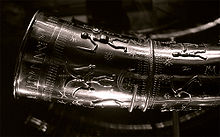 Detail of the Elder Futhark inscription on a replica of one of the 5th century AD Golden Horns of Gallehus found in Denmark.
Detail of the Elder Futhark inscription on a replica of one of the 5th century AD Golden Horns of Gallehus found in Denmark. Main article: Elder Futhark
Main article: Elder FutharkThe Elder Futhark, used for writing Proto-Norse, consists of 24 runes that are often arranged in three groups of eight; each group is referred to as an Ætt. The earliest known sequential listing of the full set of 24 runes dates to around AD 400 and is found on the Kylver Stone in Gotland, Sweden.
Each rune most probably had a name, chosen to represent the sound of the rune itself. The names are, however, not directly attested for the Elder Futhark themselves. Reconstructed names in Proto-Germanic have been produced, based on the names given for the runes in the later alphabets attested in the rune poems and the linked names of the letters of the Gothic alphabet. The letter æ was named from The Runic letter
 Called Ansuz. The asterisk before the rune names means that they are unattested reconstructions. The 24 Elder Futhark runes are:[23]
Called Ansuz. The asterisk before the rune names means that they are unattested reconstructions. The 24 Elder Futhark runes are:[23]Rune UCS Transliteration IPA Proto-Germanic name Meaning 
ᚠ f /f/ *fehu "wealth, cattle" 
ᚢ u /u(ː)/ ?*ūruz "aurochs" (or *ûram "water/slag"?) 
ᚦ þ /θ/, /ð/ ?*þurisaz "the god Thor, giant" 
ᚨ a /a(ː)/ *ansuz "one of the Æsir (gods)" 
ᚱ r /r/ *raidō "ride, journey" 
ᚲ k /k/ ?*kaunan "ulcer"? (or *kenaz "torch"?) 
ᚷ g /ɡ/ *gebō "gift" 
ᚹ w /w/ *wunjō "joy" 

ᚺ ᚻ h /h/ *hagalaz "hail" (the precipitation) 
ᚾ n /n/ *naudiz "need" 
ᛁ i /i(ː)/ *īsaz "ice" 
ᛃ j /j/ *jēra- "year, good year, harvest" 
ᛇ ï (or æ) /æː/(?) *ī(h)waz/*ei(h)waz "yew-tree" 
ᛈ p /p/ ?*perþ- meaning unclear, perhaps "pear-tree". 
ᛉ z /z/ ?*algiz unclear, possibly "elk". 

ᛊ s /s/ *sōwilō "Sun" 
ᛏ t /t/ *tīwaz/*teiwaz "the god Tiwaz" 
ᛒ b /b/ *berkanan "birch" 
ᛖ e /e(ː)/ *ehwaz "horse" 
ᛗ m /m/ *mannaz "Man" 
ᛚ l /l/ *laguz "water, lake" (or possibly *laukaz "leek") 


ᛜ ᛝ ŋ /ŋ/ *ingwaz "the god Ingwaz" 
ᛟ o /o(ː)/ *ōþila-/*ōþala- "heritage, estate, possession" 
ᛞ d /d/ *dagaz "day" Anglo-Frisian runes (5th to 11th c.)
Main article: Anglo-Saxon runesThe futhorc are an extended alphabet, consisting of 29, and later even 33 characters. It was probably used from the 5th century onward. There are competing theories as to the origins of the Anglo-Saxon Fuþorc. One theory proposes that it was developed in Frisia and later spread to England. Another holds that runes were introduced by Scandinavians to England where the fuþorc was modified and exported to Frisia. Both theories have their inherent weaknesses and a definitive answer likely awaits more archaeological evidence. Futhorc inscriptions are found e.g. on the Thames scramasax, in the Vienna Codex, in Cotton Otho B.x (Anglo-Saxon rune poem) and on the Ruthwell Cross.
The Anglo-Saxon rune poem gives the following characters and names: ᚠ feoh, ᚢ ur, ᚦ thorn, ᚩ os, ᚱ rad, ᚳ cen, ᚷ gyfu, ᚹ wynn, ᚻ haegl, ᚾ nyd, ᛁ is, ᛄ ger, ᛇ eoh, ᛈ peordh, ᛉ eolh, ᛋ sigel, ᛏ tir, ᛒ beorc, ᛖ eh, ᛗ mann, ᛚ lagu, ᛝ ing, ᛟ ethel, ᛞ daeg, ᚪ ac, ᚫ aesc, ᚣ yr, ᛡ ior, ᛠ ear.
The expanded alphabet features the additional letters ᛢ cweorth, ᛣ calc, ᛤ cealc and ᛥ stan- these additional letters have only been found in manuscripts. Feoh, þorn, and sigel stood for [f], [þ], and [s] in most environments, but voiced to [v], [ð], and [z] between vowels or voiced consonants. Gyfu and wynn stood for the letters yogh and wynn, which became [g] and [w] in Middle English.
"Marcomannic runes" (8th to 9th c.)
Marcomannic runes.
In a treatise called De Inventione Litterarum, preserved in 8th and 9th century manuscripts, mainly from the southern part of the Carolingian Empire (Alemannia, Bavaria), ascribed to Hrabanus Maurus, a runic alphabet consisting of a curious mixture of Elder Futhark with Anglo-Saxon futhorc is recorded. The manuscript text ascribes the runes to the Marcomanni, quos nos Nordmannos vocamus, and the alphabet is hence traditionally called "Marcomannic runes", but it has no connection with the Marcomanni and is rather an attempt of Carolingian scholars to represent all letters of the Latin alphabets with runic equivalents.
Wilhelm Grimm discussed these runes in 1821 (Ueber deutsche Runen, chapter 18, pp. 149–159).
Younger Futhark (9th to 11th c.)
Main article: Younger Futhark The Younger Futhark: long-branch runes and short-twig runes.
The Younger Futhark: long-branch runes and short-twig runes.
 While also featuring a runic inscription detailing the erection of a bridge for a loved one, the 11th century Ramsung carving is a Sigurd stone that depicts the legend of Sigurd.
While also featuring a runic inscription detailing the erection of a bridge for a loved one, the 11th century Ramsung carving is a Sigurd stone that depicts the legend of Sigurd.
The Younger Futhark, also called Scandinavian Futhark, is a reduced form of the Elder Futhark, consisting of only 16 characters. The reduction correlates with phonetic changes when Proto-Norse evolved into Old Norse. They are found in Scandinavia and Viking Age settlements abroad, probably in use from the 9th century onward. They are divided into long-branch (Danish) and short-twig (Swedish and Norwegian) runes. The difference between the two versions has been a matter of controversy. A general opinion is that the difference was functional; i.e. the long-branch runes were used for documentation on stone, whereas the short-branch runes were in everyday use for private or official messages on wood.
Medieval runes (12th to 15th c.)
Main article: Medieval runes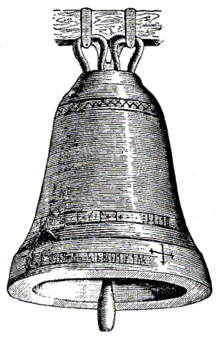 A church bell from Saleby, Västergötland, Sweden, containing a runic inscription from 1228.
A church bell from Saleby, Västergötland, Sweden, containing a runic inscription from 1228.
In the Middle Ages, the Younger Futhark in Scandinavia was expanded, so that it once more contained one sign for each phoneme of the Old Norse language. Dotted variants of voiceless signs were introduced to denote the corresponding voiced consonants, or vice versa, voiceless variants of voiced consonants, and several new runes also appeared for vowel sounds. Inscriptions in medieval Scandinavian runes show a large number of variant rune forms, and some letters, such as s, c and z, were often used interchangeably.[24][25]
Medieval runes were in use until the 15th century. Of the total number of Norwegian runic inscriptions preserved today, most are medieval runes. Notably, more than 600 inscriptions using these runes have been discovered in Bergen since the 1950s, mostly on wooden sticks (the so-called Bryggen inscriptions). This indicates that runes were in common use side by side with the Latin alphabet for several centuries. Indeed, some of the medieval runic inscriptions are actually in Latin language.
Dalecarlian runes (16th to 19th c.)
Main article: Dalecarlian runesAccording to Carl-Gustav Werner, "In the isolated province of Dalarna in Sweden a mix of runes and Latin letters developed."(Werner 2004, p. 7) The Dalecarlian runes came into use in the early 16th century and remained in some use up to the 20th century. Some discussion remains on whether their use was an unbroken tradition throughout this period or whether people in the 19th and 20th centuries learned runes from books written on the subject. The character inventory was mainly used for transcribing Elfdalian.
Academic study
Main article: RunologyThe modern study of runes was initiated in the Renaissance, by Johannes Bureus (1568–1652). Bureus viewed runes as holy or magical in a kabbalistic sense. The study of runes was continued by Olof Rudbeck Sr (1630–1702) and presented in his collection Atlantica. Anders Celsius (1701–44) further extended the science of runes and travelled around the whole of Sweden to examine the runstenar (runestones). From the "golden age of philology" in the 19th century, runology formed a specialized branch of Germanic linguistics.
Body of inscriptions
Main article: Runic inscriptions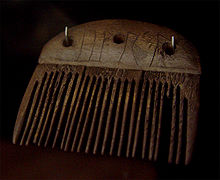 The Vimose Comb from the island of Funen, Denmark features the earliest known runic inscription (AD 150 to 200) and simply reads ᚺᚨᚱᛃᚨ "Harja", a male name.[26]
The Vimose Comb from the island of Funen, Denmark features the earliest known runic inscription (AD 150 to 200) and simply reads ᚺᚨᚱᛃᚨ "Harja", a male name.[26]
The largest group of surviving Runic inscription are Viking Age Younger Futhark runestones, most commonly found in Sweden. Another large group are medieval runes, most commonly found on small objects, often wooden sticks. The largest concentration of runic inscriptions are the Bryggen inscriptions found in Bergen, more than 650 in total. Elder Futhark inscriptions number around 350, about 260 of which are from Scandinavia, of which about half are on bracteates. Anglo-Saxon futhorc inscriptions number around 100 items.
Modern use
Runic alphabets have seen numerous usages since the 18th century Viking revival, in Scandinavian Romantic nationalism (Gothicismus) and Germanic occultism in the 19th century, and in the context of the Fantasy genre and of Germanic Neopaganism in the 20th.
Esotericism
Germanic mysticism and Nazi symbolism
Further information: Runosophy, Armanen runes, Wiligut runes, and Runengymnastik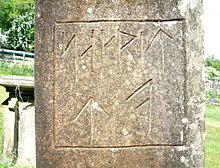 Runic script on an 1886 gravestone in Parkend, England.
Runic script on an 1886 gravestone in Parkend, England.
The pioneer of the Armanist branch of Ariosophy and one of the more important figures in esotericism in Germany and Austria in the late 19th and early 20th century was the Austrian occultist, mysticist and völkisch author Guido von List. In 1908, he published in Das Geheimnis der Runen ("The Secret of the Runes") a set of 18 so-called "Armanen runes", based on the Younger Futhark and runes of List's own introduction, which were allegedly revealed to him in a state of temporary blindness after a cataract operation on both eyes in 1902. The use of runes in Germanic mysticism, notably List's "Armanen runes" and the derived "Wiligut runes" by Karl Maria Wiligut, played a certain role in Nazi symbolism. The fascination with runic symbolism was mostly limited to Heinrich Himmler, and not shared by the other members of the Nazi top echelon. Consequently, runes appear mostly in insignia associated with the Schutzstaffel, the paramilitary organization led by Himmler. Wiligut is credited with designing the SS-Ehrenring, which displays a number of "Wiligut runes".
Modern Neopaganism and esotericism
Runes are popular in Germanic neopaganism, and to a lesser extent in other forms of Neopaganism and New Age esotericism. Various systems of Runic divination have been published since the 1980s, notably by Ralph Blum (1982), Stephen Flowers (1984 etc.), Stephan Grundy (1990) and Nigel Pennick (1995).
The Uthark theory was originally proposed as a scholarly hypothesis by Sigurd Agrell in 1932. In 2002, Swedish esotericist Thomas Karlsson popularized this "Uthark" runic row, which he refers to as the "night side of the runes", in the context of modern occultism.
J. R. R. Tolkien and contemporary fiction
In J. R. R. Tolkien's novel The Hobbit (1937), the Anglo-Saxon runes are used on a map to emphasize its connection to the Dwarves. They were also used in the initial drafts of The Lord of the Rings, but later were replaced by the Cirth rune-like alphabet invented by Tolkien. Following Tolkien, historical and fictional runes appear commonly in modern popular culture, particularly in fantasy literature, but also in other forms of media such as video games. In the Netherlands runes are used by the illustrator Hans Kresse (1921-1992) in his comic strip Eric de Noorman.
Unicode
Runic alphabets were added to the Unicode Standard in September, 1999 with the release of version 3.0.
Block
The Unicode block for Runic alphabets is U+16A0–U+16FF. It is intended to encode all shapes of runic letters. Each letter is encoded only once, regardless of the number of alphabets in which it occurs.
The block contains 81 symbols: 75 runic letters (U+16A0–U+16EA), three punctuation marks (Runic Single Punctuation U+16EB ᛫, Runic Multiple Punctuation U+16EC ᛬ and Runic Cross Punctuation U+16ED ᛭), and three runic symbols that are used in mediaeval calendar staves ("Golden number Runes", Runic Arlaug Symbol U+16EE ᛮ, Runic Tvimadur Symbol U+16EF ᛯ and Runic Belgthor Symbol U+16F0 ᛰ). Characters U+16F1–U+16FF are unassigned (as of Unicode Version 6.0).
Runic[1]
Unicode.org chart (PDF)0 1 2 3 4 5 6 7 8 9 A B C D E F U+16Ax ᚠ ᚡ ᚢ ᚣ ᚤ ᚥ ᚦ ᚧ ᚨ ᚩ ᚪ ᚫ ᚬ ᚭ ᚮ ᚯ U+16Bx ᚰ ᚱ ᚲ ᚳ ᚴ ᚵ ᚶ ᚷ ᚸ ᚹ ᚺ ᚻ ᚼ ᚽ ᚾ ᚿ U+16Cx ᛀ ᛁ ᛂ ᛃ ᛄ ᛅ ᛆ ᛇ ᛈ ᛉ ᛊ ᛋ ᛌ ᛍ ᛎ ᛏ U+16Dx ᛐ ᛑ ᛒ ᛓ ᛔ ᛕ ᛖ ᛗ ᛘ ᛙ ᛚ ᛛ ᛜ ᛝ ᛞ ᛟ U+16Ex ᛠ ᛡ ᛢ ᛣ ᛤ ᛥ ᛦ ᛧ ᛨ ᛩ ᛪ ᛫ ᛬ ᛭ ᛮ ᛯ U+16Fx ᛰ Notes - 1.^ As of Unicode version 6.0
Letters
Table of runic letters (U+16A0–U+16EA):
16A0 ᚠ fehu feoh fe f 16B0 ᚰ on 16C0 ᛀ dotted-n 16D0 ᛐ short-twig-tyr t 16E0 ᛠ ear 16A1 ᚡ v 16B1 ᚱ raido rad reid r 16C1 ᛁ isaz is iss i 16D1 ᛑ d 16E1 ᛡ ior 16A2 ᚢ uruz ur u 16B2 ᚲ kauna 16C2 ᛂ e 16D2 ᛒ berkanan beorc bjarkan b 16E2 ᛢ cweorth 16A3 ᚣ yr 16B3 ᚳ cen 16C3 ᛃ jeran j 16D3 ᛓ short-twig-bjarkan b 16E3 ᛣ calc 16A4 ᚤ y 16B4 ᚴ kaun k 16C4 ᛄ ger 16D4 ᛔ dotted-p 16E4 ᛤ cealc 16A5 ᚥ w 16B5 ᚵ g 16C5 ᛅ long-branch-ar ae 16D5 ᛕ open-p 16E5 ᛥ stan 16A6 ᚦ thurisaz thurs thorn 16B6 ᚶ eng 16C6 ᛆ short-twig-ar a 16D6 ᛖ ehwaz eh e 16E6 ᛦ long-branch-yr 16A7 ᚧ eth 16B7 ᚷ gebo gyfu g 16C7 ᛇ iwaz eoh 16D7 ᛗ mannaz man m 16E7 ᛧ short-twig-yr 16A8 ᚨ ansuz a 16B8 ᚸ gar 16C8 ᛈ pertho peorth p 16D8 ᛘ long-branch-madr m 16E8 ᛨ Icelandic-yr 16A9 ᚩ os o 16B9 ᚹ wunjo wynn w 16C9 ᛉ algiz eolhx 16D9 ᛙ short-twig-madr m 16E9 ᛩ q 16AA ᚪ ac a 16BA ᚺ haglaz h 16CA ᛊ sowilo s 16DA ᛚ laukaz lagu logr l 16EA ᛪ x 16AB ᚫ aesc 16BB ᚻ haegl h 16CB ᛋ sigel long-branch-sol s 16DB ᛛ dotted-l 16EB ᛫ single punctuation 16AC ᚬ long-branch-oss o 16BC ᚼ long-branch-hagall h 16CC ᛌ short-twig-sol s 16DC ᛜ ingwaz 16EC ᛬ multiple punctuation 16AD ᚭ short-twig-oss o 16BD ᚽ short-twig-hagall h 16CD ᛍ c 16DD ᛝ ing 16ED ᛭ cross punctuation 16AE ᚮ o 16BE ᚾ naudiz nyd naud n 16CE ᛎ z 16DE ᛞ dagaz daeg d 16EE ᛮ arlaug symbol 16AF ᚯ oe 16BF ᚿ short-twig-naud n 16CF ᛏ tiwaz tir tyr t 16DF ᛟ othalan ethel o 16EF ᛯ tvimadur symbol 16F0 ᛰ belgthor symbol Fonts
Unicode fonts that support the runic block include the following Free Unicode fonts: Junicode, Free Mono, and Caslon Roman.
The following non-free Unicode fonts also support the runic block: Alphabetum, Code2000, Everson Mono, Segoe UI Symbol, and TITUS Cyberbit Basic.
Segoe UI Symbol is included in Windows 7, meaning that the Runic alphabet is supported in that system.[27]
See also
- Codex Runicus
- Computus Runicus
- Erilaz
- Icelandic magical staves, related to runic magic
- Runamo, a false runic inscription
- Rundata
- Solomon and Saturn
- Totenkopf Ring
Other scripts, reminiscent of, based on or related to runes:
- Ogham, the early Irish monumental alphabet
- Old Italic alphabet
- Orkhon script and Old Hungarian script (sometimes referred to as Turkic and Hungarian runes)
- Siglas Poveiras
- Slavic runes (unattested sign system postulated from medieval accounts)
- the "Armanen runes", invented by Guido von List
- the Cirth "runes", invented by J. R. R. Tolkien
References
Notes
- ^ The oldest known runic inscription dates to around AD 150 and is found on a comb discovered in the bog of Vimose, Funen, Denmark (Stoklund 2003:173). The inscription reads harja; a disputed candidate for a 1st century inscription is on the Meldorf fibula in southern Jutland.
- ^ "Dictionary of the Lithuanian Language". Lkz.lt. http://www.lkz.lt/en/dze.htm. Retrieved 2010-04-13.
- ^ Odenstedt 1990; Williams 1996). Cf. Oxford Dictionary of the Middle Ages (book under preparation)
- ^ Markey 2001
- ^ Looijenga, J. H. (1997). Runes around the North Sea and on the Continent 150-700CE, dissertation, Groningen University.
- ^ Weisgerber 1968:135, 392ff. and Weisgerber 1966/67:207
- ^ Looijenga, J. H. (1997). Runes around the North Sea and on the Continent AD 150-700, dissertation, Groningen University.
- ^ Penzl (1994) assumes a period of "Proto-Nordic-Westgermanic" unity down to the 5th century and the Gallehus horns inscription. H. Penzl, Language (1994), p. 186; in greater detail in Englisch: Eine Sprachgeschichte nach Texten von 350 bis 1992 : vom Nordisch-Westgermanischen zum Neuenglischen (1994); the division between Northwest Germanic and Proto-Norse is somewhat arbitrary, see Elmer H. Antonsen, On Defining Stages in Prehistoric Germanic, Language (1965), p. 36
- ^ cited after . Antonsen (1965), p. 36
- ^ "A likely theory is that the runic alphabet was developed by the Goths, a Germanic people, from the Etruscan alphabet of northern Italy and was perhaps also influenced by the Latin alphabet in the 1st or 2nd century bc" Encyclopedia Britannica, runic alphabet
- ^ Hávamál
- ^ Larrington, Carolyne. (Trans.) (1999) The Poetic Edda, p. 37. Oxford World's Classics ISBN 0192839462
- ^ Entry DR 360 in Rundata 2.0 for Windows.
- ^ Macleod, Mindy. Mees, Bernard. (2006) Runic Amulets and Magic Objects, pp. 100–101. Boydell Press ISBN 1843832054
- ^ Page, R.I. (2005) Runes, p. 31. The British Museum Press ISBN 0-7141-8065-3
- ^ a b Foote, P.G., and Wilson, D.M. (1970). The Viking Achievement, Sidgwick & Jackson: London, UK, ISBN 0-283-97926-7
- ^ Entry Vg 63 in Rundata 2.0 for Windows.
- ^ Entry Vg 119 in Rundata 2.0 for Windows.
- ^ Hávamál at «Norrøne Tekster og Kvad», Norway.
- ^ Larrington, Carolyne. (Trans.) (1999) The Poetic Edda, p. 25. Oxford World's Classics ISBN 0192839462
- ^ a b Larrington, Carolyne. (Trans.) (1999) The Poetic Edda, p. 34. Oxford World's Classics ISBN 0192839462
- ^ Seigfried, Karl E. H. "Odin & the Runes, Part Three at The Norse Mythology Blog.
- ^ Page, R.I. (2005) Runes, pp. 8, 15, and 16. The British Museum Press ISBN 0-7141-8065-3
- ^ Jacobsen & Moltke, 1941–42, p. VII
- ^ Werner, 2004, p. 20
- ^ Looijenga, Tineke (2003). Texts and Contexts of the Oldest Runic Inscriptions. Leiden: Brill. p. 160. ISBN 9004123962.
- ^ 21 new typefaces in Windows 7
Bibliography
- Bammesberger, A and G. Waxenberger (eds), Das fuþark und Seine Einzelsprachlichen Weiterentwicklungen, Walter de Gruyter (2006), ISBN 3-11-019008-7.
- Blum, Ralph. (1932. The Book of Runes - A Handbook for the use of Ancient Oracle : The Viking Runes,Oracle Books, St. Martin's Press, New York, ISBN 0-312-00729-9.
- Brate, Erik (1922). Sveriges Runinskrifter, (online text in Swedish)
- Düwel, Klaus (2001). Runenkunde, Verlag J.B. Metzler (In German).
- Foote, P. G., and Wilson, D. M. (1970), p. 401. The Viking Achievement, Sidgwick & Jackson: London, UK, ISBN 0-283-97926-7
- Jacobsen, Lis; Moltke, Erik (1941–42). Danmarks Runeindskrifter. Copenhagen: Ejnar Munksgaards Forlag.
- Looijenga, J. H. (1997). Runes Around the North Sea and on the Continent AD 150-700, dissertation, Groningen University.
- MacLeod, Mindy, and Mees, Bernard (2006). Runic Amulets and Magic Objects. Boydell Press: Woodbridge, UK; Rochester, NY, ISBN 1843832054.
- Markey, T. L. (2001). "A Tale of the Two Helmets: Negau A and B.". Journal of Indo-European Studies 29: 69–172.
- McKinnell, John and Rudolf Simek, with Klaus Düwel (2004). Runes, Magic, and Religion: A Sourcebook. Wien: Fassbaender, ISBN 3900538816.
- Mees, Bernard (200). The North Etruscan Thesis of the Origin of the Runes. Arkiv for nordisk fililogi 115: 33–82.
- Odenstedt, Bengt (1990). On the Origin and Early History of the Runic Script, Uppsala, ISBN 9185352209.
- Page, Raymond I. (1999). An Introduction to English Runes, The Boydell Press, Woodbridge. ISBN 0-85115-946-X.
- Prosdocimi, A. L. (2003–4). Sulla Formazione Dell'alfabeto Runico. Promessa di Novità Documentali Forse Decisive. Archivio per l'Alto Adige. XCVII–XCVIII:427–440
- Robinson, Orrin W. (1992). Old English and its Closest Relatives: A Survey of the Earliest Germanic Languages Stanford University Press. ISBN 0-8047-1454-1
- Spurkland, Terje (2005). Norwegian Runes and Runic Inscriptions, Boydell Press. ISBN 1-84383-186-4
- Stoklund, M. (2003). The first runes - the literary language of the Germani in The Spoils of Victory - the North in the Shadow of the Roman Empire Nationalmuseet (?)
- Thorsson, Edred (1987). Runelore: a Handbook of Esoteric Runology. United States: Samuel Weiser, Inc.. ISBN 0-87728-667-1.
- Werner, Carl-Gustav (2004). The Allrunes Font and PackagePDF.
- Williams, Henrik (1996). "The Origin of the Runes". Amsterdamer Beiträge zur älteren Germanistik 45: 211–18.
- Williams, Henrik (2004). "Reasons for Runes". In Houston, Stephen D.. The First Writing: Script Invention as History and Process. Cambridge University Press. pp. 262–273. ISBN 0-521-83861-4. http://books.google.com/books?id=jsWL_XJt-dMC&printsec=frontcover&source=gbs_ge_summary_r&cad=0#v=onepage&q&f=false.
External links
Runes See also: Epigraphy · Runestones · Rune Poems · Runology · Runic magic ᚠ ᚢ ᚦ ᚨ ᚱ ᚲ ᚷ ᚹ ᚺ ᚾ ᛁ ᛃ ᛇ ᛈ ᛉ ᛊ ᛏ ᛒ ᛖ ᛗ ᛚ ᛜ ᛞ ᛟ Old English Futhorc: ᚠ ᚢ ᚦ ᚩ o ᚱ ᚳ c ᚷ ȝ ᚹ ᚻ ᚾ ᛁ ᛄ ᛇ eo ᛈ ᛉ x ᛋ ᛏ ᛒ ᛖ ᛗ ᛚ ᛝ ᛞ ᛟ œ ᚪ a ᚫ æ ᚣ y ᛠ ea Younger Futhark: ᚠ ᚢ ᚦ ᚬ ą ᚱ ᚴ ᚼ ᚾ ᛁ ᛅ a ᛋ ᛏ ᛒ ᛘ ᛚ ᛦ ʀ Transliteration: f u þ a r k g w h n i j ï p z s t b e m l ŋ d o Germanic peoples Languages Prehistory Roman Iron Age Migration Period Germanic Iron Age · Alamanni · Anglo-Saxons (Angles · Jutes · Saxons) · Burgundians · Dani · Franks · Frisii · Geats · Goths (Visigoths · Ostrogoths · Valagoths · Gothic Wars) · Gotlanders · Lombards · Suebi · Suiones · Vandals · Varangians · Christianization of the Germanic peoples · RomanizationSociety and culture Mead hall · Poetry · Migration Period art · Runes (Runic calendar) · Sippe · Law (Lawspeaker · Thing) · Calendar · King · Names · Numbers · Romano-Germanic cultureReligion Wodanaz · Veleda · Tuisto · Mannus · Paganism (Anglo-Saxon · Continental Germanic mythology · Frankish · Norse) · Christianity (Arianism · Gothic)Dress Warfare Burial practices List of Germanic peoples · Portal:Ancient Germanic cultureCategories:- Runic alphabet
- Runes
- Runiform scripts
- Alphabetic writing systems
- History of the Germanic peoples
- Old Italic
Wikimedia Foundation. 2010.


